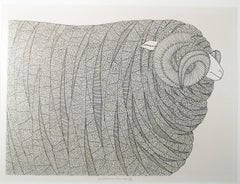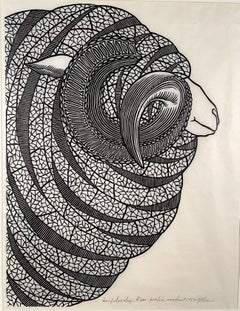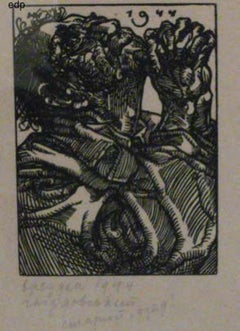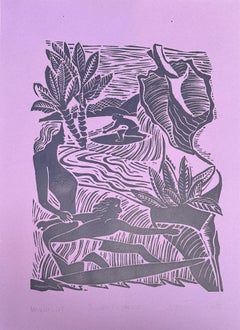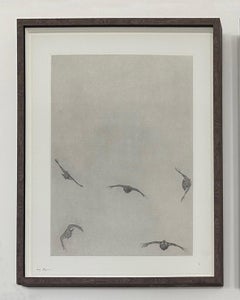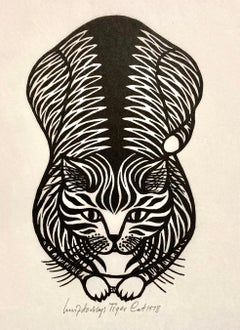Jacques Hnizdovsky Prints and Multiples
to
1
1
1
1
Overall Width
to
Overall Height
to
4
1,199
948
937
833
4
1
2
1
3
1
3
1
1
1
1
1
1
1
3
1
1
4
Artist: Jacques Hnizdovsky
FOREST IN THE SPRING
By Jacques Hnizdovsky
Located in Portland, ME
Hnizdovsky, Jacques. FOREST IN THE SPRING. T.31 Woodcut, 1960. Edition of 100. Signed, Titled, dated, numbered 10/100 and inscribed "Woodcut," all in pencil. 39 x 9 inches (sheet). I...
Category
1960s Jacques Hnizdovsky Prints and Multiples
Materials
Woodcut
RAM
By Jacques Hnizdovsky
Located in Portland, ME
Hnizdosvsky, Jacques. RAM. Tahir 370. Etching, 1979. Edition of 150.
Signed, Titled, dated and numbered 59/100, all in pencil. 16 3/4 x 23 inches In excellent
condition. Framed.
Category
1970s Jacques Hnizdovsky Prints and Multiples
Materials
Etching
RAM - PROFILE
By Jacques Hnizdovsky
Located in Portland, ME
Hnizdovsky, Jacques. RAM. Tahir 86. Woodcut., 1969. Trial Proof aside from the Edition of 100. Signed, Titled, dated and inscrbed :Trial Proof, all in pencil. 21 x 4 3/4 (image),24 ...
Category
1960s Jacques Hnizdovsky Prints and Multiples
Materials
Woodcut
PRAYER
By Jacques Hnizdovsky
Located in Portland, ME
Hnizdovsky, Jacques. PRAYER. Tahir 7. Woodcut, 1944. Artist's proof
before the edition of 100. Inscribed in pencil in Ukranian and with
the date 1944. 5 1/2 x 4 inches, plus margins...
Category
1940s Jacques Hnizdovsky Prints and Multiples
Materials
Woodcut
Related Items
Surf Elements - Surfing Art - Figurative - Woodcut Print By Marc Zimmerman
By Marc Zimmerman
Located in Carmel, CA
Surf Elements - Surfing Art - Figurative - Woodcut Print By Marc Zimmerman
Limited Edition 01/04
This masterwork is exhibited in the Zimmerman Gallery, Carmel CA.
Immerse yourself...
Category
2010s Contemporary Jacques Hnizdovsky Prints and Multiples
Materials
Woodcut
Covey of Grouse I by Guy Allen. Print from acid etching with Wooden Frame
By Guy Allen
Located in Coltishall, GB
Covey of Grouse I is a celebration of game birds in flight. A moment after taking off the birds have scattered in an explosion of aerial speed and agility. The etching reveal the d...
Category
21st Century and Contemporary Contemporary Jacques Hnizdovsky Prints and Multiples
Materials
Paper, Etching
$747
H 29.93 in W 23.23 in D 0.79 in
Covey of Grouse II by Guy Allen. Print from acid etching with Wooden Frame
By Guy Allen
Located in Coltishall, GB
Covey of Grouse II – a celebration of birds in flight.
Guy Allen’s etchings inspired by the fauna of Norfolk have a remarkable level of detail. His etchings capture the character a...
Category
21st Century and Contemporary Contemporary Jacques Hnizdovsky Prints and Multiples
Materials
Paper, Etching
$747
H 29.93 in W 23.23 in D 0.79 in
Tolosa (Toulouse); Leaf LXXI from Hartmann Schedel's Nuremberg Chronicle
Located in Middletown, NY
Woodcut on laid paper, 8 3/8 x 9 1/8 inches (212 x 233 mm), the full sheet. In excellent condition with text and portraits of Empedocles, Sapho, Zeuxis and others on the verso, as is...
Category
15th Century and Earlier Old Masters Jacques Hnizdovsky Prints and Multiples
Materials
Ink, Handmade Paper, Laid Paper, Woodcut
'Inside the Flowers' (Java Sparrow and Peach Blossoms) — Mid-Century Japanese
Located in Myrtle Beach, SC
Shoko Uemura, 'Inside the Flowers (Java Sparrow and Peach Blossoms)', color woodcut, c. 1950s, edition 300. Signed in ink with the artist’s red seal beneath. A superb impression, with fresh, delicate colors, on cream wove Japan paper; the full sheet with margins (9/16 to 1 3/8 inches), in excellent condition. Archivally sleeved, unmatted.
Image size 12 3/4 x 18 1/2 inches (324 x 470 mm); sheet size 14 3/4 x 20 3/16 inches (375 x 513 mm).
Published by The Momose Print Company of Tokyo.
ABOUT THE ARTIST
Uemura Shoko (1902-2001) was the son of the famous shin-hanga artist Uemura Shoen...
Category
1950s Showa Jacques Hnizdovsky Prints and Multiples
Materials
Woodcut
The Triumph of Caesar: Plate IV of IX
By Andrea Mantegna
Located in Middletown, NY
Andreani, Andrea, after Andrea Mantegna
The Triumph of Caesar: Plate IV of IX
1599. Chiaroscuro woodcut in colors printed from four blocks on laid paper in dark brown, grey, and thr...
Category
16th Century Old Masters Jacques Hnizdovsky Prints and Multiples
Materials
Handmade Paper, Laid Paper, Ink, Woodcut
Black Horse
By Tokuriki Tomikichiro
Located in Middletown, NY
circa 1950.
Woodblock print in black and gray ink on Japon laid paper, 10 1/4 x 15 3/4 inches (260 x 398 mm), full margins. With the artist's embossed chop mark in red ink in the l...
Category
Mid-20th Century Edo Jacques Hnizdovsky Prints and Multiples
Materials
Handmade Paper, Woodcut
1970 Tokio Mayashita-Rainy Street Woodblock Mid Century Modern
By Tokio Mayashita
Located in Brooklyn, NY
Limited edition woodblock print in colors seated in a black metal frame behind glass with a front profile of 1/4 inch and a side profile of 1 1/4 inch. Hand signed and numbered out o...
Category
1970s Modern Jacques Hnizdovsky Prints and Multiples
Materials
Woodcut
$975 Sale Price
35% Off
H 27 in W 19.75 in D 2 in
Tigre couché à l'entrée de son antre (Tiger Lying at the Entrance to its Lair)
By Eugène Delacroix
Located in Middletown, NY
Etching, drypoint, and roulette on watermarked Hallines cream laid paper, 3 3/4 x 5 7/8 inches (95 x 148 mm), full margins. A very good impression of this charming image, with all of...
Category
Early 19th Century Realist Jacques Hnizdovsky Prints and Multiples
Materials
Laid Paper, Drypoint, Etching
David Shrigley - Sorry I Snapped At You - Edition of 30
By David Shrigley
Located in London, GB
David Shrigley
Sorry I Snapped At You, 2025
Woodcut
53 x 40 cm
Edition of 30
hand-signed and numbered by the artist
published by Shäfer Editions and comes with COA from the publisher...
Category
2010s Contemporary Jacques Hnizdovsky Prints and Multiples
Materials
Woodcut
$3,263 Sale Price
20% Off
H 20.87 in W 15.75 in
The Triumph of Caesar: Plate IV
By Andrea Mantegna
Located in Middletown, NY
Andreani, Andrea (Italian, about 1558–1610), after Andrea Mantegna (Italian, 1431-1506)
Chiaroscuro woodcut in colors printed from four blocks on laid paper in dark brown, grey, and...
Category
16th Century Old Masters Jacques Hnizdovsky Prints and Multiples
Materials
Ink, Handmade Paper, Laid Paper, Woodcut
Two Goats, from "Daphnis & Chloe"
By Aristide Maillol
Located in Middletown, NY
Woodcut on hand made laid paper with the publisher's watermark designed by the artist, full margins. From the special suite of 53 woodcut illustrations which were laid in loose to t...
Category
Mid-20th Century French School Jacques Hnizdovsky Prints and Multiples
Materials
Handmade Paper, Laid Paper, Woodcut
Previously Available Items
LEAFLESS TREE
By Jacques Hnizdovsky
Located in Portland, ME
Hnizdovsky, Jacques. LEAFLESS TREE. Tahir 65. Woodcut, 1965. Signed, titled dated and inscribed "Trial Proof" in pencil. 24 x 19 1/4 inches, framed to 34...
Category
1960s Jacques Hnizdovsky Prints and Multiples
Materials
Woodcut
Tiger Cat
By Jacques Hnizdovsky
Located in New York, NY
Jacques Hnizdovsky was widely known for his woodcuts of animals. He lived in the Bronx near the zoo and was a frequent visitor.
His range of pattern-making was huge and it's applie...
Category
1970s American Modern Jacques Hnizdovsky Prints and Multiples
Materials
Woodcut
FLOCK OF LAMBS
By Jacques Hnizdovsky
Located in Portland, ME
Hnizdovsky, Jacques. FLOCK OF LAMBS. Linocut, 1975. Edition of 150. Signed, titled, dated and numbered 108/150, all in pencil. 19 x 22 inches (image) on a larger sheet. A small well ...
Category
1970s Jacques Hnizdovsky Prints and Multiples
Materials
Linocut
RAM AND EWES
By Jacques Hnizdovsky
Located in Portland, ME
Hnizdovsky, Jacques. RAM AND EWES. T.230. Woodcut, 1976. Edition of 150. Signed, titled, numbered and dated, all in pencil. 13 x 15 inches (imahe), 16 x 18 1/2 inches (sheet), matted...
Category
1970s Jacques Hnizdovsky Prints and Multiples
Materials
Woodcut
WINTER TREE
By Jacques Hnizdovsky
Located in Portland, ME
Hnizdovsky, Jacques. WINTER TREE. T.47. Woodcut, 1964. Edition of 100
published by Associated American Artists. Signed, titled, dated,
numbered 37/100, an...
Category
1960s Jacques Hnizdovsky Prints and Multiples
Materials
Woodcut
WHITE PINE
By Jacques Hnizdovsky
Located in Portland, ME
Hnizdovsky, Jacques. WHITE PINE. Tahir . Woodcut, 1970. Edition of 120. Signed, titled, dated, and numbered 19/120, all in pencil. 23 3/4 x 10 1/4 inches (sheet). In excellent condit...
Category
1970s Jacques Hnizdovsky Prints and Multiples
Materials
Woodcut
GLADIOLUS
By Jacques Hnizdovsky
Located in Portland, ME
Hnizdovsky, Jacques. GLADIOLUS. Tahir 45. Woodcut, 1964. Edition of 100. Signed, titled, dated, and numbered in pencil. 32 x 5 1/4 inches (image), 38 x 11 inches (sheet), framed to 4...
Category
1960s Jacques Hnizdovsky Prints and Multiples
Materials
Woodcut
FLAMINGO
By Jacques Hnizdovsky
Located in Portland, ME
Hnizdovsky, Jacques American, 1915-1985. FLAMINGO. Tahir 104. Woodcut, 1970. Edition of 120 published by Associated American Artists. 20 x 10 inches; 498 x 249 mm. Signed, titiled an...
Category
1970s Jacques Hnizdovsky Prints and Multiples
Materials
Woodcut
BOWL OF ROSES
By Jacques Hnizdovsky
Located in Portland, ME
Hnizdovsky, Jacques. BOWL OF ROSES. T.80. Woodcut, 1968.
7 1/2 x 6 1/2 inches. Signed, dated, titled and numbered 31/175 in pencil. In excellent condtion.
An imaginatively composed...
Category
1960s Jacques Hnizdovsky Prints and Multiples
Materials
Woodcut
WINTER LANDSCAPE
By Jacques Hnizdovsky
Located in Portland, ME
Hnizdovsky, Jacques. WINTER LANDSCAPE. T.59. Woodcut, 1965. Edition of 100. Numbered 62/100, and titled, dated, inscribed "Woodcut," and signed in pe...
Category
1960s Jacques Hnizdovsky Prints and Multiples
Materials
Woodcut
BOUQUET
By Jacques Hnizdovsky
Located in Portland, ME
Hnizdovsky, Jacques. BOUQUET. Tahir 41. Woodcut, 1964. Edition of 150. Signed, titled, dated and numbered 92/150 in pencil. 15 x 18 inches on a sheet 20 x 23 1/2 inches (matted to c....
Category
1960s Jacques Hnizdovsky Prints and Multiples
Materials
Woodcut
DAY LILLIES
By Jacques Hnizdovsky
Located in Portland, ME
Hnizdovsky, Jacques. DAY LILLIES. Tahir 286. Wood-engraving, 1980. One of 35 Artist's Proofs. Signed, titled, dated and numbered "AP 20/35." 20 x 10 inches, plus margins. In excellen...
Category
1970s American Modern Jacques Hnizdovsky Prints and Multiples
Materials
Woodcut
Jacques Hnizdovsky prints and multiples for sale on 1stDibs.
Find a wide variety of authentic Jacques Hnizdovsky prints and multiples available for sale on 1stDibs. You can also browse by medium to find art by Jacques Hnizdovsky in woodcut print, etching and more. Much of the original work by this artist or collective was created during the 20th century and is mostly associated with the modern style. Not every interior allows for large Jacques Hnizdovsky prints and multiples, so small editions measuring 14 inches across are available. Customers who are interested in this artist might also find the work of Alfred Bendiner, Millard Sheets, and Karl Schrag. Jacques Hnizdovsky prints and multiples prices can differ depending upon medium, time period and other attributes. On 1stDibs, the price for these items starts at $875 and tops out at $3,500, while the average work can sell for $1,950.

